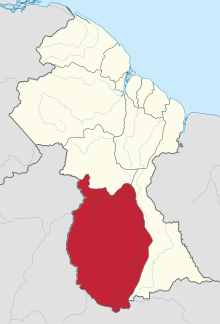Rupununi Uprising
| Rupununi Uprising | |||||||
|---|---|---|---|---|---|---|---|
| Part of Rupununi Separatism | |||||||
 South of the Guayana Esequiba | |||||||
| |||||||
| Belligerents | |||||||
|
| |||||||
| Commanders and leaders | |||||||
|
Valerie Hart Averrel John Melville |
• Ronald Rope | ||||||
| Strength | |||||||
| 120-300 Rebels, mostly indigenous[3][4] | 200 Soldiers[5] | ||||||
| Casualties and losses | |||||||
| |||||||
The Rupununi Uprising was an act of insurrection that beginning on 2 January 1969 and historically the single most serious threat to the national security and territorial integrity of Guyana on the "Zone in Reclamation" contest by Venezuela since 1966 as Guayana Esequiba. Occurring only thirty-two months after Guyana’s independence from Great Britain, it also constituted the country’s earliest and most severe test of statehood and social solidarity.
Events
Valerie Hart a member of Guyana's Amerindian Party along with her husband's family, was present in the First Conference of Amerindians Leaders, named the "Cabacaburi Congress", that presented several demands to the Prime Minister Forbes Burnham representing the community of around 40 000 indigenous people of the Rupununi district.[8] The movement defended the integration of the natives to the Guyanese society, inconsonant with the afrocentrists policies of Burnham; the indigenous society at the South Esequibo felt threatened by the possible distribution agricultural parcels among the sectors that supported the Minister, driving the inhabitants of the Rupununi district to rebel against the authorities. According to Valerie Hart, the reasons that drove the region's population to rebel against the government was the fact that the constitutional rights were not being respected due to the continuous intimidation and repression against them.[9]
The peasants rebelled on the morning of 2 January 1969 against the authorities of the district, taking hostages, public buildings and airports. The police station in the town of Lethem, the administrative center of the Rupununi District, was attacked by ranchers, who were armed with bazookas and automatic weapons. Valerie Hart was named as the first president of the Esequibo Free State that requested immediately the Venezuelan protection of Raul Leoni 's government. News about the insurrection reached Georgetown by midday that day and policemen and soldiers of Guyana Defence Force were flown into Manari by Guyana Airways. The rebellion was violently quelled that night resulting in the destruction of many indigenous houses, around 100 deaths and the flight of many natives to Brazil and Venezuela.[10]
Lethem Police Station was completely wrecked by bazooka shells and policemen were riddled by bullets as they tried to escape. Annai and Good Hope stations were seized and the personnel held captive along with other Government officials and civilians in the abattoir at Lethem.
Aftermath
Five policemen and one civilian were killed, the government dispenser was shot and wounded, and a number of persons, including the District Commissioner and his wife, were herded into the abattoir and held hostage. The names of the five policemen killed during the uprising are as follows: Inspector #4412 Whittington Braithwaite; Sergeant #4590 Benedict AD Sukra; Constables #5611, James McKenzie; #5691 William Norton and #7178 Kendall Michael.
Seven of those charged with murder were acquitted: Ignatius Charlie, 23; Anaclito Alicio, 20; Handel Singh, 28; Francis James, 20; Charles Davis, 20; Damian Phillips, 21; Brenton Singh, 43. When the government forces moved on Lethem the rebels fled, eventually going across the Brazilian border.
The judge ordered that Colin Melville, 22; Aldwyn Singh, 41; and Patrick Melville, 17 be retried for murder, but charges were later dropped by the Director of Public Prosecutions.
Reactions
On January 5, 1969, days after the plot had failed, the Venezuelan government of Raul Leoni, through its foreign minister, Ignacio Iribarren Borges, publicly rejected the request of the leader of the separatist movement, Valerie Hart, to help the rebels to annex Rupununi to Venezuela. That same day, the Foreign Minister of Guyana accused Venezuela before the United Nations of supporting the revolt and trying to re-annex the territory.
After the uprising, the President of Venezuela, Rafael Caldera, and Guyana Prime minister Forbes Burnham, concerned with the moratory of reclamation of Guayana Esequiba, signed the Port of Spain Protocol in 1970. Venezuelan maps produced since 1970 show the entire area from the eastern bank of the Essequibo, including the islands in the river, as Venezuelan territory. On some maps, the western Essequibo region is called the "Zone in Reclamation".[11]
References
- ↑ https://www.aporrea.org/actualidad/a12600.html,"Venezuela y el golpe en Guyana".
- ↑
- ↑ , The Trail of Diplomacy: The Guyana-Venezuela Border Issue (Volume Two).
- ↑ Ishmael, Dr. Odeen. "The Trail of Diplomacy - A Documentary History of the Guyana-Venezuela Border Issue"
- ↑ , La insurrección de Rupununi.
- ↑ , The Trail of Diplomacy: The Guyana-Venezuela Border Issue (Volume Two).
- ↑ , The Rupununi Revolt.
- ↑ Amerindian News Georgetown: vol 2, No 3, May 15thy 1968.
- ↑ Ramírez Colina, Oswaldo (13 September 2007). "La insurrección de Rupununi". monografías.com (in Spanish). Retrieved 12 November 2017.
- ↑ Márquez, Oscar J. (29 December 2008). "La Guyana Esequiba y la Primera Conferencia de Jefes Amerindios en Cabacaburi. Parte II". La Guayana Esequiba (in Spanish). Retrieved 12 November 2017.
- ↑ Ishmael, Dr. Odeen. "The Trail of Diplomacy - A Documentary History of the Guyana-Venezuela Border Issue"